La Femme
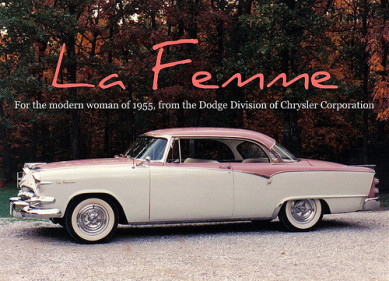
I am jet-lagged and punchy this morning. It had been a pretty good flight back into DCA- Ronald Reagan National on the signs- and we made it in between thunderstorms spawned by the Polar Vortex that is making this an unseasonably pleasant summer.
Given how surreal everything else is these days, I thought I might take a little digression on some surreal moments from the not-so-far past.
I was talking about the impromptu rumble seat that Dad cut out of our Nash Metropolitan. That led in short order to cruising around eBay motors to see what was out there. I am currently following an auction that has a few days to go- I won’t tell you which one so that you will not be tempted to false flag the process and drive up the cost, not that anyone ever does anything like that, but here is the little number I have been watching:
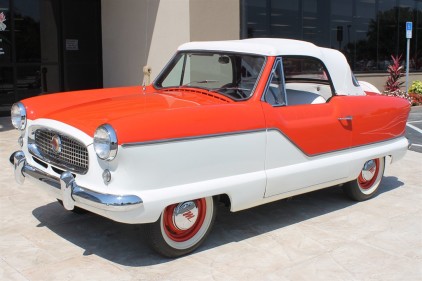
It doesn’t hurt to watch, right?
The only problem with that was the other car I was just watching- the 1973 Mercedes 350SL that I bought by mistake. Well, that is another story and all’s well that ends well, I suppose.
Anyway, I was researching the history of the cute little Metro and read about the marketing scheme. The Metro had a lot of things going for it, and one of the most important features George Mason was trying to sell was the concept of the “second car.” The sub-context in those prehistoric times was that it was intended to get Dad just to the train station to go into the City, or for the stay-at-home Mom to run errands. Hence the cuteness angle, baked in by the designers at Pininfarina at the independent coachbuilder at Cambiano, Italy.
I am certainly comfortable enough with the idea of flying around town in the proto-Smart Car of its day- easy to park, 30 MPG on the road, and all that- and would resent the idea that the car was designed to appeal to the women’s market in motor cars.
Some brands and models have been associated with subtle touches that implied a more gentle approach to design than say, a Charger 440 R/T with the Hemi. I am thinking budvases in the modern incarnation of the VW Beetle. I flogged a red 1968 hardtop Beetle for a hundred thousand miles back in the day, and a bud vase would have been the furthest thing from anyone’s imagination in those things.
I should add that classic as one of the cars I should have kept to pair up with the black-and-white convertible we called “Shamu” down in Florida. But I digress. Again. That is the problem with cars.
As part of the research into the Metro brand and ten year history of production, I came across something I had never run into- or run into me, rather, to be more precise. It was the first car specifically aimed at the motoring American woman.
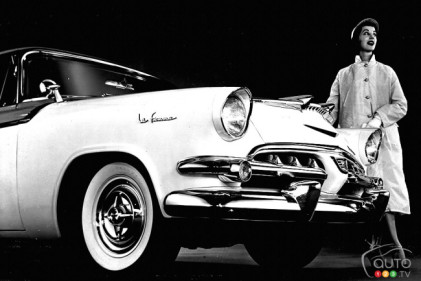
(Early advertising for La Femme. Original ad from Chrysler via Auto TV).
It was called “La Femme,” and was part of the 1955 Big Year for Chrysler motorcars. Chrysler was the smallest of the Big Three car companies, and despite the fact that everything that rolled, sold in the early 1950s, it took a major re-capitalization and organizational transformation to make Chrysler stay in the rear view of GM and Ford.
We Rambler people were proud of being one of the “Little Two” companies with Studebaker, not that it saved either in the long run. Nor in fact did it save Chrysler, which is owned by Fiat these days. But again, I digress.
Virgil Exner was the stylist in charge of the massive new roll out that was going to restore greatness to Chrysler. Dad talked about him in the same sort of reverence that he talked about GM’s Harley Earl: they were men who designed the sizzle into the American automobile. Earl’s greatest contribution might have been the Corvette, a vehicle that existed only because…well, because Harley thought it should exist.
Over at Chrysler, Exner was at the top of his game in 1955. The smooth new rides he created were ballyhooed in the late summer of 1954 in anticipation of the unveiling of the new Model year. The company hyped what was coming in un-illustrated black-and-white ads under the banner “The 100 Million Dollar Look.”
I know, I know. A hundred million bucks these days is viewed as a rounding error on the health care law, but it meant something back then, and the new car roll-out in the Fall was very much like Oscar Night in Detroit when the curtain came up on the new model year. Hard to believe now, but then it was a black tie event. Hell, you could even tell what company had built the car just by looking at it.
I defy anyone to do that today- and doubt further that anyone cares.
For 1955, Dodge/Chrysler had some technical marvels (the punch-button transmission was just one) and ten body styles in three series, divided into two door and four-door sedans, two door hardtops, two door wagons, four door wagons, and two door convertibles. The three series were the Coronet, the Royal and Custom Royal, the flagship of the Dodge line.
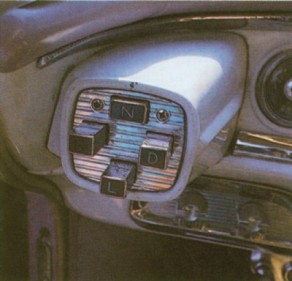
(Iconic Chrysler transmission buttons from a La Femme still in the wild, captured in Ypsilanti, MI by Steve Brown).
The Custom Royal Lancer had chrome rear fins and unique taillight and backup light bezels, plus a deluxe interior. The fender fins and sweep spear side trim were added to the late model year Custom Royal four door sedan trim package. But Virgil did not stop there. He made a Custom Royal Lancer that he thought would appeal to the female driving public. He called it the La Femme. It came with the slogan ”By Special Appointment to Her Majesty… the American Woman.”
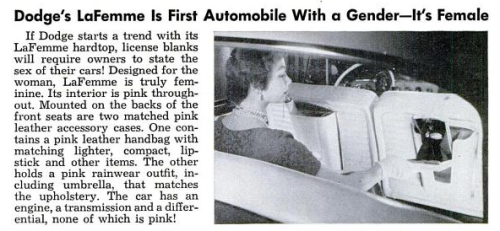
(Some contemporary commentary in the pages of Popular Mechanics. An adjoining article described how to build a scale model B-36 Bomber at home.)
The La Femme was mechanically not different than its brothers in the factory. What set it apart was a special trim option with Heather Rose and Sapphire White color combinations.
La Femme’s exterior also had special gold-colored “La Femme” script on the fenders. The vehicle’s interior was graced with special tapestry upholstery bearing pink rosebuds on a pale pink background and pale pink vinyl trim. A matching cape, boots, umbrella, shoulder bag, and floral tapestry-like fabrics were added as feminine niceties. Other accessories included a purse with compact, lipstick case, cigarette case, lighter and change purse. These accessories were color-coordinated to match the rosebud interior and were stored in compartments on the back of the front seats.
Over two years of production, roughly 2,500 Dodge La Femmes were built before the vehicle disappeared into the annals of automotive history. Obviously, Virgil Exner did not have female designers on his team, and there was nothing like the “focus groups” that would have evaluated his design then. The review team would be much more like the characters on Mad Men.
I think of it as a bunch of guys designing a car they thought women might like.
Freud had that one nailed, didn’t he? Guys are pretty much clueless.
Perhaps sixty specimens of the La Femme remain today, one of which is displayed at the Auburn Hills Chrysler headquarters complex. The Walter P. Chrysler Museum might be the best place to see one. It is certainly better than trying to tour the old Dodge Main plant in Hamtramck where they were built:
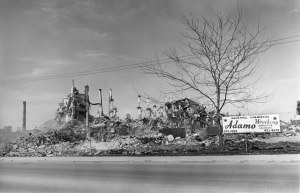
(The old Dodge Main Assembly Plant today, Hamtramck, MI.)
Copyright 2014 Vic Socotra
www.vicsocotra.com
Twitter: @jayare303
